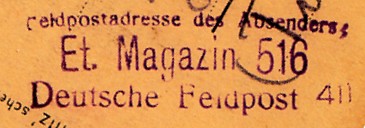Feldpost 1914-1918
Postmarks
The Importance of the Postal Service During the First World War (1914–1918).
Military headquarters fully recognised the vital role of mail in maintaining soldiers' morale. Receiving news from home was essential for their well-being. It is estimated that over 28 billion postal items passed through the German military postal system during the four years of war.
Modern means of communication at the time, such as the telegraph and telephone, remained inaccessible to ordinary soldiers and their families. Consequently, postal correspondence dominated exchanges, primarily in the form of letters, postcards, parcels, and money transfers. The military postal service granted soldiers postage-free privileges for most mail and applied reduced fees for money transfers.
1914: A Military Postal System Put to the Test.
Before the war, the German military postal service had been organised in anticipation of a potential conflict with France. Lessons learned from the Franco-Prussian War of 1870 had contributed to improvements, yet these preparations proved inadequate in the face of the unprecedented upheavals brought about by the First World War. Designed for a war of movement, the system could not have foreseen the scale of troop movements and the vast distances involved. As a result, significant difficulties arose in mail delivery within the first weeks of the conflict.
Although railways were used for postal transport, they were not prioritised, as military convoys were reserved for troops and munitions. Furthermore, the rapid movement of soldiers made it difficult to track units, leading to delays in the delivery of mailbags.
Neither the civilian nor the military postal system had anticipated the sheer volume of mail and parcels being sent in both directions. These challenges resulted in severe backlogs of undelivered post, both in Germany and on the front lines.
It was only towards the end of 1914 that the system began to stabilise and function more efficiently. The shift to trench warfare enabled better organisation of the military postal service.
1915–1916: An Optimised Postal System Facing Logistical Challenges.
By 1915, the military postal service had become more structured across all fronts. However, frequent issues with incomplete or inaccurate addresses led to stricter postal regulations to minimise time-consuming searches and improve mail distribution.
Regulations also tightened regarding parcel contents. Families often sent perishable goods, flammable liquids, or matches, posing risks to entire shipments. Some soldiers even attempted to send home recovered battlefield munitions, creating serious hazards.
Despite improved planning, the available transport resources remained insufficient in both quantity and quality, particularly the horse-drawn vehicles used for mail delivery.
A major challenge was the shortage of qualified personnel. Many civilian postal workers were requisitioned for service in the military postal system or assigned to combat units. In Germany, these losses were offset by the recruitment of auxiliary staff, both men and women, who required training and did not always meet expectations.
A similar situation arose in military post offices, where experienced staff were sometimes reassigned to combat units. This forced the administration to employ auxiliary workers, who were often less efficient. Moreover, the continuous creation of new divisions necessitated the establishment of additional post offices, further depleting the ranks of experienced personnel.
1917–1918: A Postal Service Disrupted by Shortages and Offensives.
From late 1917 onwards, worsening shortages across Germany further strained the postal service. The lack of spare parts and fuel for vehicles, as well as the scarcity of grease and coal for trains, severely impacted mail delivery. Additionally, preparations for the major offensives of spring and summer 1918 monopolised most logistical resources, making the postal service even more precarious.
Despite these difficulties, the military postal service managed to sustain deliveries to troops on the front lines. However, railway transport remained saturated, as moving troops and munitions took absolute priority. The dispatch of parcels from soldiers to their families also became increasingly problematic. Facing shortages in Germany, many soldiers sought to send home food and various goods, often purchased or looted from occupied territories.
When Allied offensives breached the German front, the military postal service was forced to retreat alongside the troops. The lack of transport options significantly slowed mail and parcel deliveries, even as their volume remained high. By October 1918, even the most modest soldiers recognised the war’s inevitable outcome. Many sought to send home whatever they could—food, objects, clothing, fabric, and money—before the collapse of the front.
The Collapse of the Postal Service After the Armistice.
The days following the Armistice of 11 November 1918 were marked by chaos in the remaining occupied territories, particularly in Belgium, where German troops were in full retreat. In this context, the military postal service gradually ceased operations, as its personnel moved back towards Germany.
This collapse marked the end of a service which, despite its shortcomings, had successfully maintained communication between soldiers and their families throughout the war.
Date Stamps: Evolution and Specificities
At the start of mobilisation, post offices were equipped with single-circle date stamps. However, these were soon replaced by bridge-type date stamps, which gradually became the standard. Unlike the single-circle stamps, which displayed only the day and month, bridge-type stamps included the full date in the format day/month/year.
The absence of the year on the early military postal date stamps stemmed from a practice inherited from previous conflicts. Until then, wars were generally short, rarely lasting more than a year, making the inclusion of the year unnecessary. However, as the war unexpectedly dragged on, some date blocks were modified to include the year as well. In most post offices, both types of date stamps were used simultaneously.
Bridge-type date stamps (except for Bavarian models) also featured a time indication, followed by abbreviations:
- V (Vormittag – morning)
- N (Nachmittag – afternoon)
System for Differentiating Date Stamps
A distinctive feature of German date stamps was the possible addition of an alphabetical letter alongside postal markings. These letters, ranging up to "d," were used to distinguish between multiple date stamps that were being used simultaneously or successively within the same post office. This differentiation system (Unterscheidungs-buchstabe) had been in use since 1875 in both civilian and military postal services.
Organisation of Military Post Offices
In the field, the German military postal system was structured around three types of post offices, each equipped with specific date stamps. The inscriptions on these stamps varied depending on the office’s role in mail distribution.
Army Corps Post Offices : Feldpostamt
These post offices managed the mail for the Army Corps. They were overseen by a Field Postmaster (Feldpostmeister). These offices had authority over the divisional post offices, ensuring the organisation and distribution of mail within their respective corps.
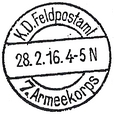

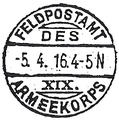

Divisional Post Offices: Feldpostexpedition
These post offices handled mail for the Divisions and operated under the authority of the Army Corps post offices (Feldpostamt). They were responsible for managing the distribution and dispatch of correspondence within their assigned divisions.
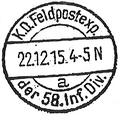

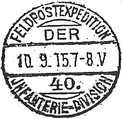


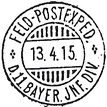
Stationary Post Offices: Feldpoststation
These offices managed mail for troops stationed in the rear areas (Etappe) for extended periods. They were generally fixed in location, but as the war progressed, some were relocated to different towns as required by the evolving military situation.
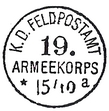

Prussian date stamp
Saxon date stamp
Prussian date stamp
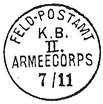

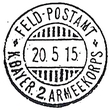

Bavarian date stamp
Bavarian date stamp


Prussian date stamp
Prussian date stamp
Saxon date stamp
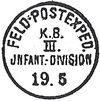

Bavarian date stamp
Bavarian date stamp
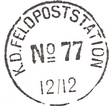

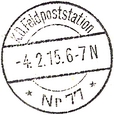

Bavarian date stamp


Bavarian date stamp


Bavarian date stamp
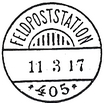


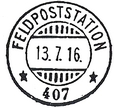


Bavarian date stamp
Bavarian date stamp
Prussian date stamp
Prussian date stamp
The Army Corps and Divisional Post Offices were mobile, while the stationary post offices served units stationed in one location for an extended period.
As the war progressed and trench warfare became dominant, it became clear that the existing date stamps were too revealing. They allowed Allied intelligence agents to accurately locate German units based on postmarks.
As a result, from 15 February 1917, post office designations were changed, making it impossible to identify military units through date stamps. To enhance operational security, post offices were required to use:
"Camouflaged" date stamps (Tarnstempel), inscribed with “Deutsche Feldpost" followed by a number. Unit post offices (Feldpostamt and Feldpostexpedition) were assigned numbers ranging from 650 to 1021. Stationary post offices (Feldpoststation) were given numbers from 1 to 649 and 2001 to 3113. These special date stamps were exclusively used on registered letters and mail containing valuables, ensuring that standard correspondence did not reveal the location of military units.
"Dumb" or star date Stamps (Stummen Stempel)
In addition to the camouflaged date stamps, some post offices were issued "silent" date stamps or star stamps, which bore the inscription "Deutsche Feldpost" followed by three stars.
These stamps were designed to further obscure the origin of military correspondence, preventing enemy intelligence from determining the location of German units.
Furthermore, as of 15 February 1917, very few post offices had received the newly designed date stamps. To prevent sensitive information from being revealed, military post offices were ordered to file down any identifying inscriptions on existing date stamps that could indicate a specific post office or military unit. These filed-down date stamps (ausgestanzte Stempel) were to be used until the new models arrived.
However, delays in manufacturing the new stamps meant that their distribution was prioritised as follows:
1. Newly established post offices received the first batches.
2. Post offices that had lost or broken their original date stamps were supplied next.
3. Offices still using filed-down or scratched date stamps were among the last to receive replacements.
This gradual rollout meant that filed-down date stamps remained in use for an extended period before the new camouflaged models were fully implemented.
As a result, some field post offices never received a dumb date stamp and continued to use their filed one until the end of the war. Even so, this did not fool Allied spies, who were able to reconstruct the filed date stamps. It was therefore decided in October 1917 that each field post office of the same Army should exchange its filed date stamp with another.

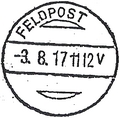


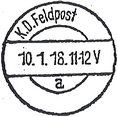

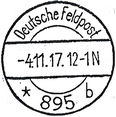

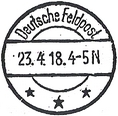


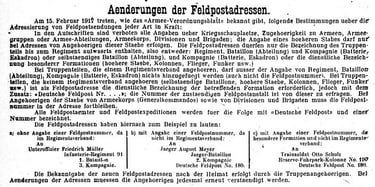
"On 15th February 1917, as announced by the Official Army Journal, the following regulations regarding addresses for military postal shipments will come into effect:
All references to theatres of operations, affiliations with Armies, Army Groups, Army Detachments, Army Corps, Divisions, and Brigades are prohibited in addresses. The mention of a High Command is only permitted for members of these commands. Addresses may include only the designation of a military unit up to a maximum level of Regiment, meaning: Regiment, Battalion (Detachment), and Company (Battery, Squadron) or independent Battalion (Detachment), Company (Battery, Squadron), as well as the official designation of specific formations (High Commands, Columns, Aviators, Radio Operators, etc.).
No additional details may be included except for the Regiment, Battalion (Detachment), and Company (Battery, Squadron)—not even the Feldpost number for units belonging to a Regiment.
For troops that do not belong to a Regiment (independent Battalions, High Commands, Columns, Aviators, Radio Operators, etc.), the address must include "Deutsche Feldpost Nr...." The Feldpost number must be obtained from the relevant military post office. For members of the High Command of Army Corps, Divisions, and Brigades, the Feldpost number must remain in the address. All Army Corps and Divisional post offices are thus designated with "Deutsche Feldpost" followed by a number.
Examples of correct military postal addresses:
Extract from the 1st Army Journal dated 1st February 1917 (Somme-Wacht No. 12, 01/02/1917).
a) Without the inclusion of a Feldpost number in addition to the Regiment:
An Unteroffizier Friedrich Müller
Infanterie-Regiment 91.
1. Bataillon
3. Kompagnie
b) With the inclusion of a Feldpost number (for units not belonging to a Regiment):
An Jäger August Meyer
Jäger-Bataillon
2. Kompagnie
Deutsche Feldpost N° 180
c) With the inclusion of a Feldpost number (for a special formation not belonging to a Regiment):
An Trainsoldat Otto Schulz
Reserve-Fuhrpark-Kolonne n° 190
Deutsche Feldpost N° 180
Soldiers are responsible for informing their relatives of their new addresses. Their relatives must be notified of any change of address."
Unit or Service Stamps
Unlike date stamps, unit stamps were not part of the officially supplied equipment for military post offices.
These stamps were privately manufactured at the request and expense of various military units (regiments, battalions, companies, etc.). Due to this decentralised production, an extremely wide variety of unit stamps existed, with nearly half a million different models recorded.
Their primary function was to indicate the name of the sending unit, often accompanied by the number or name of the military post office to which it was attached. However, these inscriptions were frequently very brief, often reduced to a sequence of initials or abbreviations that were difficult to interpret. In response to this issue, and at the request of the military postal service, unit stamps gradually became more explicit after several months of war.
An Essential Role Despite Their Non-Postal Status
Although these stamps were not official postal markings, they nonetheless served an essential function:
They granted postal exemption for letters and postcards that bore them.
They confirmed that the sender was indeed a soldier or an individual authorised to use the military postal service.
Typically, the soldier would also manually write the following information on the envelope or postcard:
His name
His rank
His unit
The number of the post office serving his unit
A letter lacking a unit stamp or a handwritten sender’s inscription could be rejected and returned to the sender.
Continued Use Until the End of the War
Unit stamps were used throughout the conflict and were often pre-stamped on blank envelopes or postcards to speed up mail processing.
It is common to find cards or envelopes bearing only a unit stamp, without a date stamp from the military post office. This was because, during periods of high postal traffic, military post offices were instructed not to apply date stamps in order to save time and avoid delaying outgoing mail convoys.


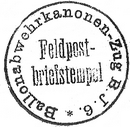

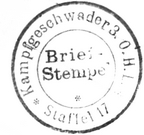

After 15 February 1917, unit stamps were no longer allowed to include overly explicit information, such as place names, Divisions, Army Corps, or Army designations. As with date stamps, unauthorised inscriptions were removed to prevent sensitive military details from being disclosed.
Over time, new unit stamps were produced in accordance with the updated regulations, ensuring compliance with the stricter security measures.
